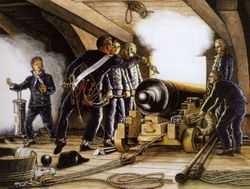18-pounder long gun
| 18-pounder long gun | |
|---|---|
 Firing of a 18-pounder. Engraving by Louis-Philippe Crépin. | |
| Type | naval gun |
| Place of origin | France |
| Service history | |
| Used by | France, Spain, Great Britain, Netherlands, Sweden, USA |
| Specifications | |
| Weight |
2.060 metric tons |
| Barrel length | 2.572 metres (18.544 calibres) |
|
| |
| Calibre | 138.7 mm[1] |
The 18-pounder long gun was an intermediary calibre piece of artillery mounted on warships of the Age of sail. They were used as main guns on the most typical frigates of the early 19th century, on the second deck of third-rate ships of the line, and even on the third deck of late first-rate ships of the line.
Usage
As the 18-pounder calibre was consistent with both the French and the British calibre systems, it was used in many European navies between the 17th and the 19th century. It was a heavy calibre for early ships of the line, arming, for instance, the main batteries of the Couronne in 1636. From the late 18th Century, the French Navy used the 18-pounder in three capacities: as the main gun on frigates, as the battery on the upper gundeck of two-deckers, and lastly on the top deck of three-deckers.
French frigates began carrying the 18-pounder under Louis XV, when the two Pourvoyeuse class frigates, originally designed to carry 24-pounders, were equipped with it; at the time, a typical frigate would carry 12-pounders. Under Louis XVI, from 1779, the 18-pounder gradually became the standard calibre for frigates, starting with the Hébé Class. These frigates were build on standard patterns designed by Jacques-Noël Sané, carrying 26, and later 28 main guns, complemented with smaller pieces on the forecastle. Around 130 of these frigates were built. At the end of the Empire, 24-pounder frigates began supplanting the 18-pounder frigates. Frigates built after the Bourbon restauration, used a different artillery system, one involving 30-pounders.
On two-deckers, the 18-pounder was mounted on the upper deck as secondary artillery, to complement the 36-pounder main artillery on the lower deck. A 74-gun would carry thirty 18-pounders; this lighter secondary battery added firepower to the ship without raising the centre of gravity too much. In rough weather, vessels often could not use their main battery lest water enter through the gun-ports, and the secondary battery then became the vessel's main armament; for example, the Droits de l'Homme was effectively reduced to the firepower of a frigate when she fought the action of 13 January 1797 in stormy weather, leading to her destruction at the hand of two British frigates that would normally not have been a match for her; in the opposite case, during the Glorious First of June, the Vengeur du Peuple used her main batteries but became unmanageable and sank after taking in water from her lower gun-ports whose covers had been ripped off in a collision with HMS Brunswick.[2]
Three-deckers used 36-pounders on their lower decks and 24-pounders on their second deck. Until 1803, the third deck was equipped with 12-pounder guns, as a heavier gun would have destabilised the ship; after this date, however, Sané introduced design improvements that allowed installation of 18-pounder on the third deck of Impérial; later 120-gun ships of the line used the same arrangement; these ships carried thirty-four 18-pounders.
The Royal Navy used the 18-pounder on frigates, which carried 28 guns. Fourth rates ships carried 26 on their secondary batteries, and third rates carried 28. Unlike the French, the British used second rates, of 90 to 98 guns; the 90-gun vessels carried thirty 18-pounders on their middle deck, while the 98-gun vessels carried a total of sixty 18-pounders, distributed over both the second and the third deck. First rates carried thirty-four 18-pounders on their third deck and 24-pounders on the middle deck.
Sources and references
| Wikimedia Commons has media related to 18-pounder long guns. |
- ↑ French naval regulation, 1786
- ↑ Le Vengeur livre son dernier combat
- (French) Jean Boudriot et Hubert Berti, L'Artillerie de mer : marine française 1650-1850, Paris, éditions Ancre, 1992 (ISBN 2-903179-12-3) (notice BNF no FRBNF355550752).
- (French) Jean Peter, L'artillerie et les fonderies de la marine sous Louis XIV, Paris, Economica, 1995, 213 p. (ISBN 2-7178-2885-0).
| |||||||||||
| |||||||||||